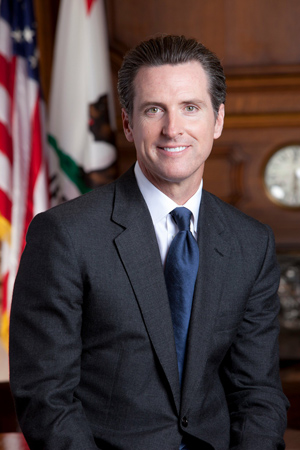November 21, 2019 - SACRAMENTO – Governor Gavin Newsom yesterday issued the following statement regarding the Legislative Analyst’s Office’s annual state budget outlook:
 “This budget assessment points to a broader truth. California is now the fifth-largest economy in the world. Our state is proving what big-hearted, progressive governance can look like – all without breaking the bank. President Trump talks a lot about America’s economic growth under his presidency, but when you look behind the numbers, you see that it’s California’s growth that has provided the economic rocket fuel for the nation.
“This budget assessment points to a broader truth. California is now the fifth-largest economy in the world. Our state is proving what big-hearted, progressive governance can look like – all without breaking the bank. President Trump talks a lot about America’s economic growth under his presidency, but when you look behind the numbers, you see that it’s California’s growth that has provided the economic rocket fuel for the nation.
“As Washington soaks Americans with a trillion dollars in debt to pay for tax cuts that benefit the wealthy and destroys the social safety net, our state is now doing more than ever before to provide opportunity for all California families, especially those who are not equally sharing in our nation’s prosperity. We are taking important steps so that growth is broadly shared, doing it all while saving record amounts for a rainy day.
“As our state and nation face uncertain economic headwinds, the federal government would be wise to look to California as a model for how to get its fiscal house in order.”
Source: Office of the Governor
Legislative Analyst’s Office
The 2020-21 Budget - California's Fiscal Outlook
Read the Report
Executive Summary
Does the State Have Enough Resources to Pay for Next Year’s Commitments?
The first aim of the Fiscal Outlook is to answer whether the state will have sufficient resources to pay for its existing commitments in the upcoming budget year (in this case, 2020‑21). As has been the case in recent years, the answer to this question is yes. Moreover, we find that the budget has an estimated, additional $7 billion surplus available in 2020‑21. (We use the term “surplus” to mean the amount of revenues that exceeds spending under current law and policy.) In the upcoming budget season, the Legislature will allocate this amount between making new budget commitments (like spending increases or tax reductions), paying down debts, and building more reserves.
Does the State Have Capacity to Take on New, Ongoing Commitments?
Second, the report addresses what share of the $7 billion surplus in 2020‑21 is available to be allocated to ongoing purposes (meaning amounts that occur annually) versus one‑time purposes (meaning amounts that are spent or saved only in 2020‑21). To address this question, we look at two different expenditure scenarios. We find the state has:
- Ongoing Surplus of $3Billion Under Baseline Expenditure Scenario. In our baseline expenditure scenario, we find the state has an ongoing surplus of around $3 billion. Importantly, this scenario assumes the federal government approves the managed care organization (MCO) tax and the state faces no major disasters over the next few years. (The MCO tax offsets General Fund costs in Medi‑Cal but it requires federal approval.)
- Ongoing Surplus Drops Below $1Billion in Alternative Expenditure Scenario. There are a number of risks to the baseline expenditure scenario—including, for example, that the federal government might not approve the MCO tax. In our alternative expenditure scenario, where this and other similarly plausible events—outside the Legislature’s control—occur, we find the state has .an ongoing surplus of less than $1 billion.
Consequently, assuming the economy continues to grow, the state has capacity to take on new, ongoing commitments. The extent of that capacity depends on how the Legislature views possible risks to the budget like those in our alternative expenditure scenario.
If a Recession Begins, Does the State Have Enough Reserves to Cover Revenue Shortfalls?
Finally, the Fiscal Outlook assesses whether the state has enough savings—or budget reserves—to cover revenue shortfalls in a recession. We find that the state now is in good shape to weather a recession typical of the post‑World War II era. This shows the significant progress California has made in preparing for a downturn. It does not mean, however, that the state is prepared to weather any possible recession. In fact, many of the nation’s post‑war recessions were milder than more recent recessions have been. Moreover, a recession of similar economic size but with more significant stock market drops would have much larger impacts on the state budget.
Comments and Recommendations
Budget Is in Good Condition. California’s budget continues to be in a good position. We estimate the Legislature will have a $7 billion surplus available to allocate in the upcoming budget process, and in addition, will build an $18.3 billion balance in the state’s rainy day fund by the end of 2020‑21. With more than a decade of economic expansion, coupled with deliberate legislative action to put the budget on better footing, the California budget is in good condition.
Suggest Caution in Allocating Available Surplus. We think there are reasons for the Legislature to be cautious in allocating the estimated $7 billion surplus. Given the findings of our alternative expenditure scenario—which reflects possible costs to the budget outside of the Legislature’s control—we recommend the Legislature initially plan to dedicate no more than $1 billion of the estimated $7 billion surplus to ongoing purposes in 2020‑21. Moreover, because there are signals suggesting the potential for weaker economic performance than our outlook currently assumes, we suggest the Legislature allocate a significant portion of the surplus toward building reserves and paying down debt. For the remaining surplus, we recommend the Legislature focus on one‑time, flexible commitments that can be changed mid‑year if economic conditions change.
Source: LAO








